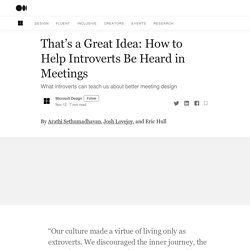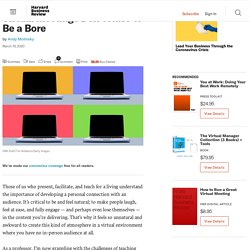

Microsoft's CEO Knows How to Run a Meeting. Here's How He Does It. Do You Really Need to Hold That Meeting? Stop Zoning Out in Zoom Meetings. Break Up Your Big Virtual Meetings. A BBC reporter on how to be a video conference rock star. Video conferencing has proven invaluable for the army of workers sent home to work there, but it didn’t take long for the buzz of seeing everyone on Zoom, Teams, Skype, WebEx, or Meet to wear off.

Many of us who learned to perform well in person are struggling to adapt to working with others through a webcam. “A video conference is definitely more taxing” than an in-person meeting, says Richard Taylor, who reported for the BBC for nearly 25 years before founding SuperRichMedia, a boutique video consulting and training company in San Francisco. Other experts have weighed in on the format’s inherent drain on workers’ energies. Video meeting can also be less effective, he says, “because you’re unable to scan the room in the same way, and get the feedback from other people. You’re absolutely aware that you are performing, even when you’re not speaking.
Based on his online course in effective videoconferencing, Richard gave us a bullet list of ways to make the most of the format. How to Be a Great Listener in Remote Meetings. Why Your Meetings Stink—and What to Do About It. How Brené Brown Runs Emotionally Intelligent Zoom Meetings. How to Foster Psychological Safety in Virtual Meetings. How to Fix the Most Soul-Crushing Meetings. How to Hold Rewarding Brainstorming Sessions Remotely.
That’s a Great Idea: How to Help Introverts Be Heard in Meetings. “Our culture made a virtue of living only as extroverts.

We discouraged the inner journey, the quest for a center. So we lost our center and have to find it again.” — Anaïs Nin One of the most popular TED talks of all time is by Susan Cain, whose book The Power of Introverts in a World That Can’t Stop Talking struck a less-than-silent chord with a population whose value we often overlook: introverts. Even though between one-third and half of the population is introverted, Western culture exhibits a bias toward extroversion. Gregariousness is often falsely conflated with productivity, adults encourage quieter kids to “come out of their shells,” and extroverts rate as smarter, better looking, and more interesting. Of course, this isn’t all or nothing; ambiverts exist, and depending on the context, the degree to which you feel introverted or extroverted may change.
Yet there’s much to learn from studying introverted behavior, particularly when it comes to designing meeting experiences. 10 Ways to Engage People in Your Online Meetings. Virtual Meetings Don’t Have to Be a Bore. Executive Summary Many professionals — leaders, consultants, teachers — are having to move their meetings and classes online.

Creating an engaging and personal environment in this new context is challenging and won’t feel natural for everyone. The author, a professor and consultant, shares what he’s learned from his experience teaching and facilitating online. His advice includes: embracing the differences between an in-person and online setting and recognizing there are advantages to the latter; making it feel personal; getting used to delayed feedback; convey warmth and presence; and keeping it interactive. We’ve made our coronavirus coverage free for all readers. Those of us who present, facilitate, and teach for a living understand the importance of developing a personal connection with an audience. As a professor, I’m now grappling with the challenges of teaching and presenting in a COVID-19 world and have recently brought my classes online as a result of the pandemic.
Not All Meetings Are Equal. Here’s How To Make Yours Ultra Productive. Why do so many meetings suck?

It turns out that, despite humans’ natural gifts for collaboration, we have some systemic bad habits when it comes to gathering for work purposes. The good news is we do have it in us to make meetings ultra productive. The bad news is, every meeting minute we waste is more expensive than we think. Last year, a study by a scheduling company called Doodle estimated that poorly organized business meetings were responsible for $399 billion in lost productivity in the US, and $58 billion in the UK.
In the Doodle study, nearly half of people said that poorly organized meetings prevented them from getting work done. It would be easy to say that the reason for all this meeting waste is laziness. Technologies like email and Slack have made it possible to fill up every corner of our workday with reactionary tasks. The cost of bad meetings. How to Run A POWERful Meeting - Agile by Design Inc. Have you ever looked up halfway through a meeting wondering what the heck the reason for the meeting is!?

Have you ever ended a meeting, with no clear direction or action items? I know I have, and it can be frustrating. As an Agile Coach, traditional boardroom meetings are not something that we tend to advocate for. We lean towards more fluid interactions such as quick huddles ideally around a work visualization system like a Kanban board.